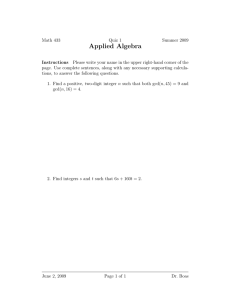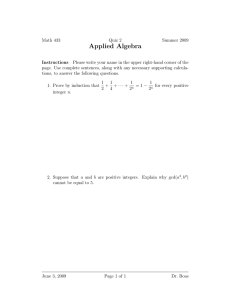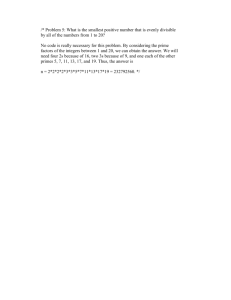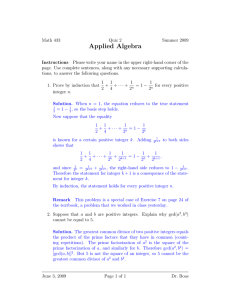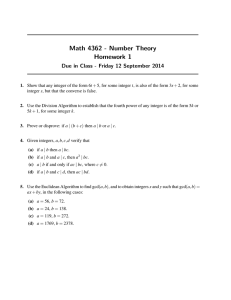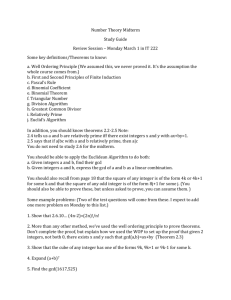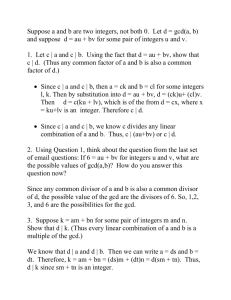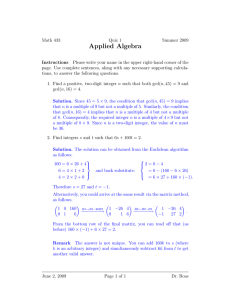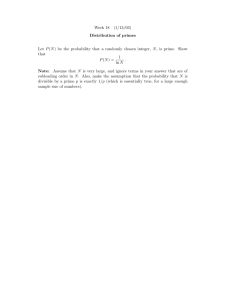Document 10581231
advertisement
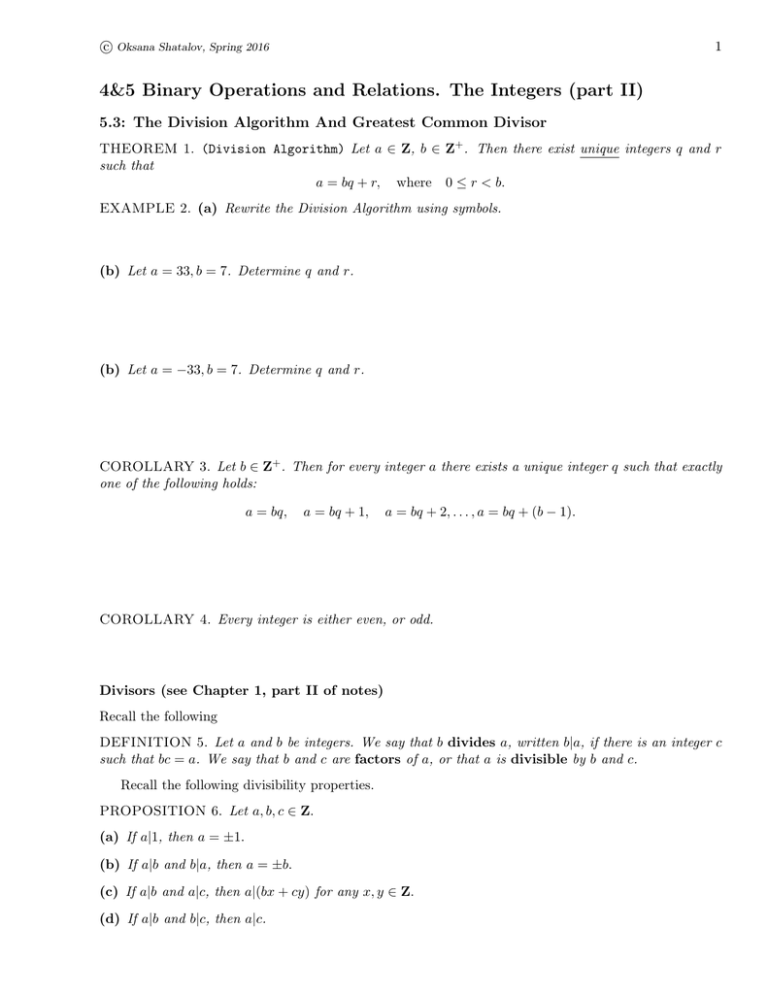
c Oksana Shatalov, Spring 2016 1 4&5 Binary Operations and Relations. The Integers (part II) 5.3: The Division Algorithm And Greatest Common Divisor THEOREM 1. (Division Algorithm) Let a ∈ Z, b ∈ Z+ . Then there exist unique integers q and r such that a = bq + r, where 0 ≤ r < b. EXAMPLE 2. (a) Rewrite the Division Algorithm using symbols. (b) Let a = 33, b = 7. Determine q and r. (b) Let a = −33, b = 7. Determine q and r. COROLLARY 3. Let b ∈ Z+ . Then for every integer a there exists a unique integer q such that exactly one of the following holds: a = bq, a = bq + 1, a = bq + 2, . . . , a = bq + (b − 1). COROLLARY 4. Every integer is either even, or odd. Divisors (see Chapter 1, part II of notes) Recall the following DEFINITION 5. Let a and b be integers. We say that b divides a, written b|a, if there is an integer c such that bc = a. We say that b and c are factors of a, or that a is divisible by b and c. Recall the following divisibility properties. PROPOSITION 6. Let a, b, c ∈ Z. (a) If a|1, then a = ±1. (b) If a|b and b|a, then a = ±b. (c) If a|b and a|c, then a|(bx + cy) for any x, y ∈ Z. (d) If a|b and b|c, then a|c. c Oksana Shatalov, Spring 2016 2 Greatest common divisor (gcd) DEFINITION 7. Let a and b be integers, not both zero. The greatest common divisor of a and b (written gcd(a, b), or (a, b)) is the largest positive integer d that divides both a and b. EXAMPLE 8. Find gcd(18, 24). EXAMPLE 9. (a) Compute gcd(−18, 24) = gcd(−24, −18) = and make a conclusion. (b) Compute gcd(5, 0) = gcd(−5, 0) = and make a conclusion. (c) Complete the statement: If a 6= 0 and b 6= 0, then gcd(a, b) ≤ (d) Let c ∈ Z. Then gcd(a, ac) = Euclidean Algorithm is based on the following two lemmas: LEMMA 10. Let a and b be two positive integers. If a|b then gcd(a, b) = |a| . LEMMA 11. Let a and b be two positive integers such that b ≥ a. Then gcd(a, b) = gcd(a, b − a). Proof. c Oksana Shatalov, Spring 2016 3 COROLLARY 12. Let a and b be integers, not both zero. Suppose that there exist integers q1 and r1 such that b = aq1 + r1 , 0 ≤ r1 < a. Then gcd(a, b) = gcd(a, r1 ). Procedure for finding gcd of two integers (the Euclidean Algorithm) c Oksana Shatalov, Spring 2016 4 EXAMPLE 13. Find gcd(1176, 3087). EXAMPLE 14. Find integers x and y such that 147 = 1176x + 3087y. COROLLARY 15. If d = gcd(a, b) then there exist integers x and y such that ax + by = d. Moreover, d is the minimal natural number with such property. Relatively prime (or coprime) integers DEFINITION 16. Two integers a and b, not both zero, are said to be relatively prime (or coprime), if gcd(a, b) = 1. For example, Combining the above definition and the proof of Corollary 15, we obtain THEOREM 17. a and b are relatively prime integers if and only if there exist integers x and y such that ax + by = 1. c Oksana Shatalov, Spring 2016 5 THEOREM 18. Let a, b, c ∈ Z. Suppose a|bc and gcd(a, b) = 1. Then a|c. Proof. 5.4: Primes and Unique Factorization DEFINITION 19. An integer p greater than 1 is called a prime number if the only divisors of p are ±1 and ±p. If an integer greater than 1 is not prime, it is called composite. -7 -4 0 1 2 4 7 10209 Sieve of Eratosthenes. The method to find all primes from 2 to n. 1. Write out all integers from 2 to n. 2. Select the smallest integer p that is not selected or crossed out. 3. Cross out all multiples of p (these will be 2p, 3p, 4p, . . . ; the p itself should not be crossed out). 4. If not all numbers are selected or crossed out return to step 2. Otherwise, all selected numbers are prime. EXAMPLE 20. Find all two digit prime numbers. 21 41 61 81 2 22 42 62 82 3 23 43 63 83 4 24 44 64 84 5 25 45 65 85 6 26 46 66 86 7 27 47 67 87 8 28 48 68 88 9 29 49 69 89 10 30 50 70 90 11 31 51 71 91 12 32 52 72 92 13 33 53 73 93 14 34 54 74 94 15 35 55 75 95 16 36 56 76 96 17 37 57 77 97 18 38 58 78 98 19 39 59 79 99 20 40 60 80 REMARK 21. It is sufficient to cross out the numbers in step 3 starting from p2 , as all the smaller multiples of p will have already been crossed out at that point. This means that the algorithm is allowed to terminate in step 4 when p2 is greater than n. In other words, if the number p in step 2 is greater √ than n then all numbers that are already selected or not crossed out are prime. c Oksana Shatalov, Spring 2016 6 Prime Factorization of a positive integer n greater than 1 is a decomposition of n into a product of primes. Standard Form n = p1 p2 · · · pk , where primes p1 , p2 , . . . , pk satisfy p1 ≤ p2 ≤ . . . ≤ pk Compact Standard Form n = pα1 1 pα2 2 · · · pαmm , where primes p1 , p2 , . . . , pm satisfy p1 < p2 < . . . < pm and α1 , α2 , . . . , αm ∈ Z. EXAMPLE 22. Write 1224 and 225 in a standard form (i.e. find prime factorization). LEMMA 23. Let a and b be integers. If p is prime and divides ab, then p divides either a, or b. (Note, p also may divide both a and b.) Proof. COROLLARY 24. Let a1 , a2 , . . . , an be integers.If p is prime and divides a1 a2 · . . . · an , then p divides at least one integer from a1 , a2 , . . . , an . Note that Lemma 23 corresponds to n = 2. General proof of the above Corollary is by induction. THEOREM 25. (Second Principle of Mathematical Induction) Let P (n) be a statement about the positive integer n. Suppose that P (1) is true. Whenever k is a positive integer for which P (i) is true for every positive integer i such that i ≤ k, then P (k + 1) is true. Then P (n) is true for every positive integer n. c Oksana Shatalov, Spring 2016 7 THEOREM 26. Unique Prime Factorization Theorem. Let n ∈ Z, n > 1. Then n is a prime number or can be written as a product of prime numbers. Moreover, the product is unique, except for the order in which the factors appears. Proof. Existence: Use the Second Principle of Mathematical Induction. P (n) : Basic step: Induction hypothesis: Inductive step: Uniqueness Use the Second Principle of Mathematical Induction. P (n) : Basic step: Induction hypothesis: c Oksana Shatalov, Spring 2016 8 COROLLARY 27. There are infinitely many prime numbers. Proof. EXAMPLE 28. Prove that if a is a positive integer of the form 4n + 3, then at least one prime divisor of a is of the form 4n + 3. Proof.
